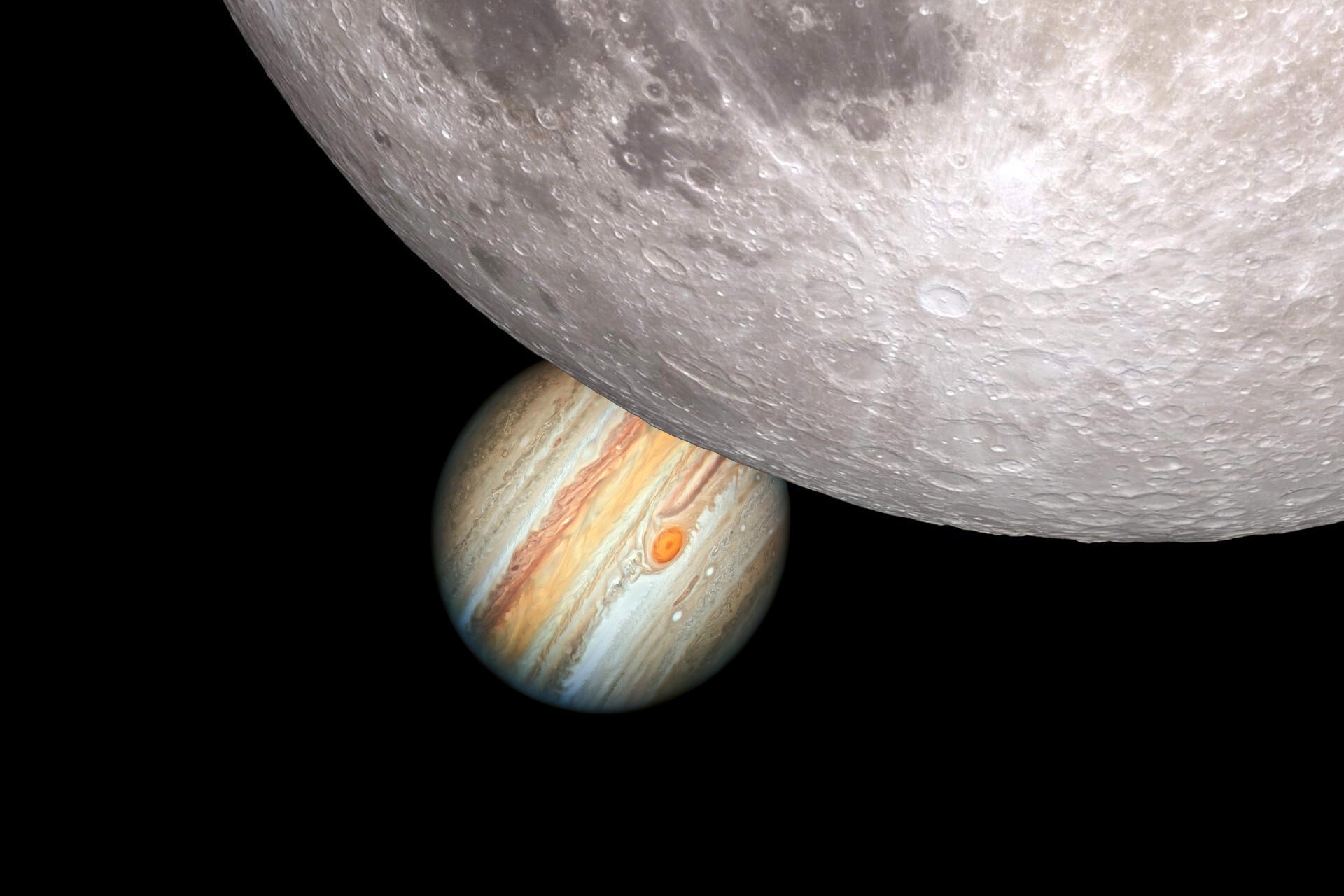
الاحتجاب هو حدث سماوي يحدث عندما يتم إخفاء كائن بواسطة كائن آخر يمر بينه وبين المراقب. في هذا الرسم التوضيحي لغطاء المشتري ، نرى قمرنا يمر مباشرة بين الأرض والمشتري ، وبالتالي يحجب أو “يخفي” المشتري عن الأنظار. هذا حدث نادر نسبيًا لأنه يتطلب محاذاة القمر والمشتري بشكل وثيق للغاية على طول خط الرؤية من الأرض. عندما يحدث ذلك ، يمكن أن يكون مشهدًا رائعًا للهواة وعلماء الفلك المحترفين على حد سواء. الائتمان: رسم توضيحي للفنان باستخدام صور ناسا للمشتري والقمر
ما هي بعض المعالم البارزة في مراقبة السماء في مايو 2023؟
Jupiter disappears behind the Moon for some U.S. observers. Plus, some key differences in the Southern Hemisphere’s skies compared to those of the North.
https://www.youtube.com/watch؟v=KneIfbdJcUg
لقد وصلنا إلى “ذروة كوكب الزهرة” في سماء المساء ، والقمر يحجب كوكب المشتري في غرب الولايات المتحدة زائد ، ما الذي يجعل سماء نصف الكرة الجنوبي فريدة من نوعها؟
- طوال الشهر – بعد غروب الشمس منذ بداية العام ، يصل كوكب الزهرة إلى أعلى نقطة له في سماء المساء في مايو ، ويبدأ في الاتجاه الهبوطي كل مساء ، ويتجه إلى يونيو. يختفي من سماء المساء بحلول أواخر يوليو ، ويعود للظهور في سماء الصباح بعد حوالي شهر.
- 5 مايو – اكتمال القمر
- 13 مايو – ابحث عن الكوكب[{” attribute=””>Saturn rising together with a third-quarter (or half-full) moon in the southeast in the couple of hours before sunrise.
- May 17 – A slim crescent moon rises about an hour before the Sun, with Jupiter quite closeby, for much of the U.S. and Canada. From some Southern U.S. states, observers will be able to see Jupiter passing behind the Moon as the pair rise in morning twilight.
- May 19 – New moon
- May 22-24 – Following sunset on May 22-24, the Moon, Venus, and Mars form a close grouping in the west. The Moon sits between the two planets on the 23rd.
Video Transcript
What’s Up for May? Planets strike a pose with the Moon, we reach “peak Venus,” and what’s different about the skies of the Southern Hemisphere.
On the morning of May 13th, find the planet Saturn rising together with a third-quarter (or half-full) moon. Find them together in the southeast in the couple of hours before sunrise.
Then on May 17th, a slim crescent moon rises about an hour before the Sun,
and from much of the U.S. and Canada, the planet Jupiter will appear very close to the Moon. But from some southern U.S. states, you’ll be able to observe Jupiter passing behind the Moon as the pair rise in morning twilight. And from the western states, Jupiter will actually be behind the Moon, in occultation, as the pair rise. Jupiter will start to emerge from behind the Moon as the Sun comes up. Now, this will be quite low in the sky, so you’ll need a clear view of the horizon to observe it, and a pair of binoculars will be a big help as the sky begins to brighten.
Next, following sunset on May 22nd through the 24th, the Moon, Venus, and Mars form a close grouping in the west. The Moon sits between the two planets on the 23rd.
Venus has been rising higher in the sky each evening for the past few months. That begins to change in May, as the brilliant planet reaches its highest point in the western sky, and starts trending lower as we move into June. It’ll disappear from evening skies by late July, reappearing in the eastern sky about a month later as a morning object.
There are some key differences between the night sky in the Southern Hemisphere, compared to the North. To start with, there’s no counterpart to the North Star for the Southern Hemisphere. The celestial poles shift over time, so eventually there will be a “South Star,” but not at the moment.
Next, from Orion to the Teapot to the Gemini twins, the seasonal star patterns northern observers are most familiar with appear flipped upside down when viewed in southern skies. The Moon also appears the other way around, and its phases fill up from left to right, instead of right to left as they do in the north.
Stars near the north celestial pole, including Ursa Major and Cassiopeia are below the horizon for much of the Southern Hemisphere. But there are lots of dazzling constellations easily visible only from the Southern Hemisphere, like Crux, Carina, Tucana (the toucan), and Centaurus (the centaur)!
Next, while observers in both hemispheres are well-acquainted with the brightest star in the sky, Sirius, Southern Hemisphere skywatchers get to enjoy the second and third brightest stars, as well. The second-brightest star, Canopus, appears about half as bright as Sirius, but that’s still quite bright. And the two stars are often seen together in southern skies. The third brightest star in our skies here on Earth is also the closest star system to our own – Alpha Centauri. It’s too far south in the sky to be visible for most of the Northern Hemisphere. But it’s quite well-known to skywatchers to the south.
Finally, there are two entire galaxies easily observed in the southern sky with the unaided eye. These are the Magellanic Clouds, which are dwarf galaxies that orbit our galaxy the Milky Way. They make for a stunning sight in night sky photos from Southern latitudes.
And that’s a really short list of some of the ways the skies above the Southern Hemisphere are unique. Our view of the cosmos may be different from one part of the planet to the other, but the insights we gain from looking up and exploring are something we all can share.
Here are the phases of the Moon for May.

The phases of the Moon for May 2023. Credit: NASA/JPL-Caltech
Stay up to date with all of NASA’s missions to explore the solar system and beyond at nasa.gov. I’m Preston Dyches from NASA’s Jet Propulsion Laboratory, and that’s What’s Up for this month.

“مدمن ثقافة البوب. عشاق التلفزيون. نينجا الكحول. إجمالي مهووس البيرة. خبير تويتر محترف.”


:max_bytes(150000):strip_icc():focal(749x0:751x2)/Shohei-Ohtani-dog-first-pitch-tout-1-082924jpg-953710b5907e41dfa6827ec1c99cf28b.jpg)
/cdn.vox-cdn.com/uploads/chorus_asset/file/25594197/Genki_TurboCharger_Hero.jpg)



More Stories
المفتش العام لوكالة ناسا يصدر تقريرا قاسيا بشأن تأخير مشروع إطلاق المركبة الفضائية SLS
كيف أصبحت الثقوب السوداء بهذا الحجم والسرعة؟ الإجابة تكمن في الظلام
طالبة من جامعة نورث كارولينا ستصبح أصغر امرأة تعبر حدود الفضاء على متن بلو أوريجين